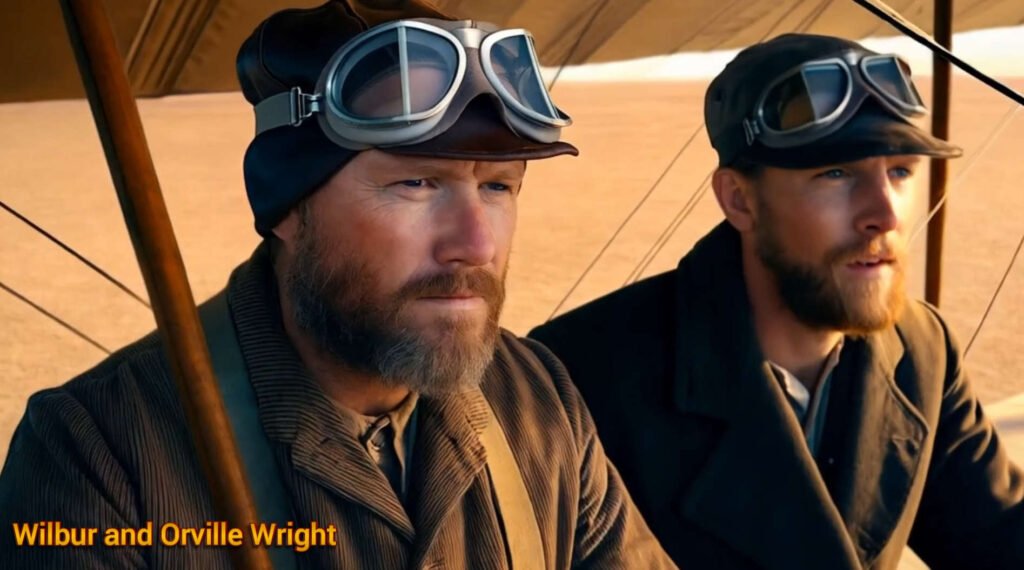Long long ago, people looked up at the sky and dreamed of flying like birds. They watched eagles soar high above and thought, “Wouldn’t it be amazing to join them up there?”
Some brave people (but not very smart) even tried jumping off cliffs with homemade wings! Of course, that didn’t work out so well, but the dream of flying didn’t go away.
Video Showing How Airplane was Invented
10th Century “The Flying Scholar”

Imagine standing in a crowded square in 10th-century Iran, watching a man leap from a mosque roof with wooden wings strapped to his arms. This was the fate of Ismail ibn Hammad al-Jawhari, a Turkish scholar with dreams of flight. His wings failed, and he plummeted to his death, but his daring sparked the imaginations of future aviators.
Evolution of Aviation
Smart inventors came up with lots of cool ideas to help humans get off the ground. They made drawings of flying machines and tried building different things to lift people into the air.
These early ideas were really important, even though most of them didn’t work. It’s like they were building steps that led to the airplanes we have today.
Hot Air Balloon Invention
Then, in 1783, two brothers named Joseph and Etienne Montgolfier made a huge breakthrough. They created the first successful hot air balloon that could lift people into the air! This was super exciting, and it proved that human flight was really possible.
But people still wanted to fly like birds, with wings and engines.
Wright Brothers: Inventors of First Flight

Many years passed, and then in 1903, two more brothers made history. Wilbur and Orville Wright built a flying machine with wings and an engine.
On December 17, 1903, their plane, called the Wright Flyer, took off from the ground and flew for 12 seconds! This was the beginning of a big adventure in flying that continues even today.
Since then, airplanes have evolved dramatically.
How Planes Evolved to Present Day!
In 1939, Helicopter – The idea of taking off vertically, the VS-300, the world’s first practical helicopter, took flight at Stratford, Connecticut. After World War II the commercial use of helicopters developed rapidly in many roles, including fire fighting, police work, agricultural crop spraying, mosquito control, medical evacuation, and carrying mail and passengers.
In World War I, planes were used for military purposes, leading to rapid advancements in aircraft design and performance. The 1920s and 30s saw the rise of commercial aviation, with companies like Boeing and Douglas creating larger, more comfortable planes for passenger travel.
World War II brought even more progress, with the development of jet engines. In 1939, the first jet-powered aircraft, the Heinkel-He-178, took flight in Germany. This technology revolutionized aviation, allowing for much faster and higher-altitude flights.
The post-war era saw the dawn of the Jet Age. Commercial jet airliners like the de Havilland Comet and Boeing 707 transformed long-distance travel, making it faster and more accessible than ever before.
But humans didn’t stop at conquering the skies – we set our sights on space. The Space Race of the 1960s pushed the boundaries of flight even further. In 1961, Yuri Gagarin became the first human to journey into outer space, and in 1969, Neil Armstrong took his historic first step on the moon.
Today, we have supersonic jets, massive airliners like the Airbus A380, and reusable spacecraft like SpaceX’s Falcon 9.
We use planes for all sorts of things now, like traveling to far-away places, delivering packages, and even exploring space!
Drones Need a Special Mention
In a world full of new ideas and discoveries, the future of airplanes is very exciting. Unmanned Aircraft Systems (UAS), commonly known as drones need a special mention.
In farming, drones are changing how we grow crops by using special sensors to check plant health and spray fertilizers accurately. Drones also help in delivering important medical supplies to faraway places quickly, and we are starting to see cool electric planes for cities and drones that deliver goods without harming the environment. Drones are even helping to keep us safe by watching borders, helping police, and protecting animals and nature. These amazing technologies are reshaping different jobs, solving big problems, and leading us toward a future where we can do incredible things that we never thought possible.
Who knows what amazing flying machines we’ll have in the future?
The next time you see an airplane in the sky, remember the long journey it took to get there, starting with people who dared to dream of flying.


